If you make an open pond for swimming and recreation in the country, then it must be an indoor pool. No films or thermal blankets will protect the water mirror from evaporation, debris and heat loss. In addition, this is still a good way to protect the place of rest from living creatures in the country, including birds and pets.
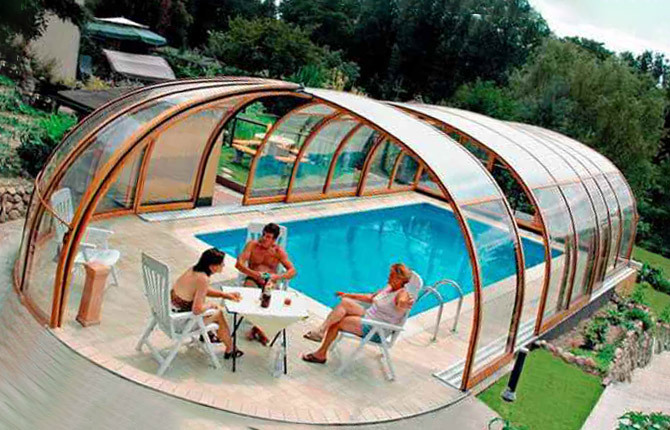
The content of the article:
-
Features of canopies over pools
- Advantages
- Flaws
- Choosing a design and design
-
Indoor pool materials and tools
- Types of pools
- Roof types and roof shapes
-
Step-by-step instructions for creating an indoor pool
- Foundation preparation
- Indoor pool bowl installation
- Supports for covered superstructure
- Making the frame of the covered part
- Assembling the frame of the covered part
- Laying cladding for an indoor pool
Features of canopies over pools
For most pool owners, the installation of a roof over the surface of the pond is most often associated with the need to protect against pets. Therefore, the first desire is to make an inexpensive arched cap, which is easy to install at night and clean while swimming in the pool.
Only with time comes the understanding of how much higher the level of comfort when swimming in an indoor pool. Making an indoor pool with your own hands is not difficult, you just need to plan the building correctly.
Advantages
Protecting the water surface is not considered the main benefit of an indoor pool, although it is also important. A canopy for a pool or a full-fledged roof over a pond is made in order to:
- Reduce heat loss, especially during the cold season. If desired, you can swim in the heated pool even in late autumn or winter.
- To prevent those who got out of the water and wished to rest on the side or at the table to catch a cold in the cold.
- Protect bathers from ultraviolet rays of the sun. It is much more convenient to swim in the heat, being under a protective canopy in a shaded space.
- Reduce water loss due to rain.
A heavy downpour quickly brings a huge amount of organic matter into the pool, due to which the water requires cleaning and disinfection. Swimming in an indoor pool in a country house is much safer than swimming in an open pond that has turned green from breeding algae.
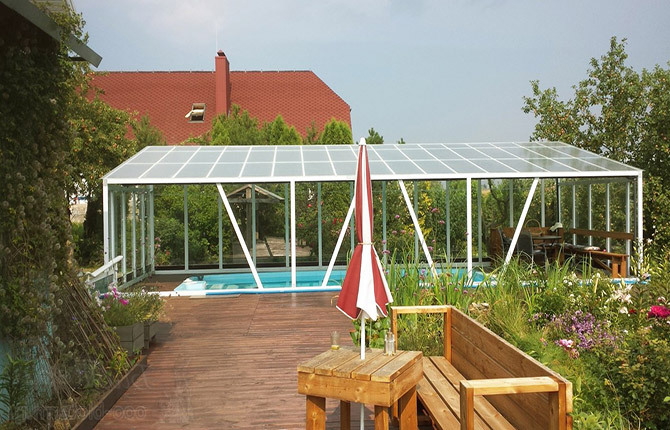
Flaws
The disadvantages of indoor pool structures are no less than the positive aspects. A canopy or arched roof is quite expensive, so they are often made by hand. Each reservoir, despite the fact that it is built according to a standard scheme, is a unique structure with its own size, shape and design of the bowl. Therefore, the roof has to be designed from scratch, taking into account all the nuances of the design.
Periodically, the structure of the canopy-roof needs to be updated, repaired, disinfected, like all other parts of the pool. A warm, humid environment promotes the intensive development of microalgae and fungus. In addition, wooden and metal parts of the roof under the influence of water vapor can be destroyed, which means that additional maintenance is required.
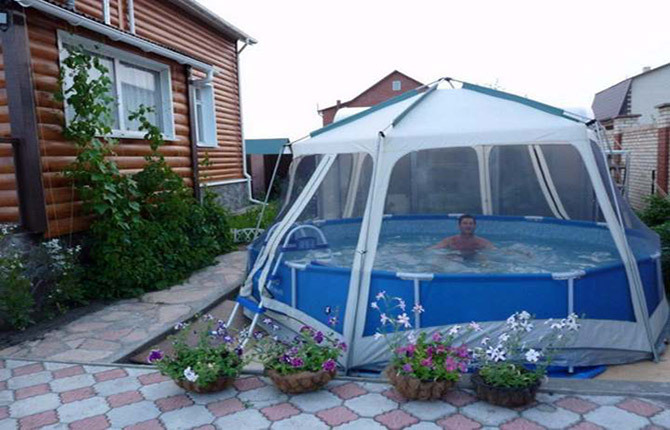
Interesting: How to make a pool in the country with your own hands.
Choosing a design and design
The first thing you need to pay attention to is the scheme for installing a protective dome or roof over the mirror of the pool. The canopy-roof frame must be installed and fastened on a separate concrete foundation. Moreover, the covered part cannot be connected with the edge of the plastic bowl or try to fix the frame to the side of the pool. This will inevitably lead to the destruction of the bowl.
Even with a slight breeze, the roof frame experiences significant transverse loads (up to 100 kg). Therefore, a separate foundation is made for the covered part.
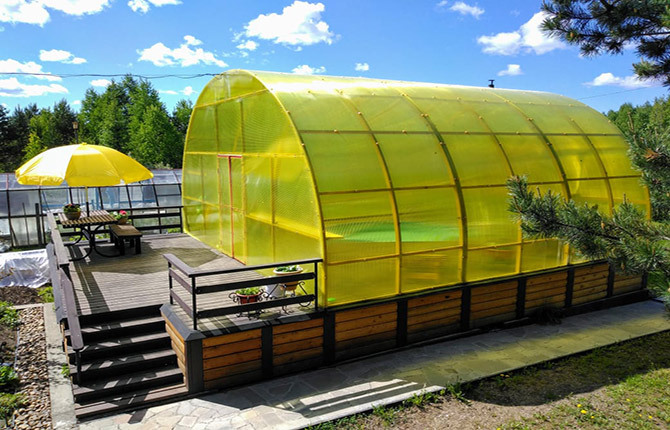
For self-construction of an indoor pool, the classic version with a superstructure in the form of a stationary boathouse is best suited.
This arrangement of a covered superstructure has a number of advantages:
- simple scheme, all parts are easy to manufacture;
- small costs;
- no moving parts.
It is important that the roofed superstructure has a minimum of hinges and moving parts. As practice shows, home-made folding canopies, tilting on hinges "shells", moving towards the section require regular maintenance. As parts wear out, the roofed superstructure is increasingly failing. Therefore, the fewer moving parts, the longer the superstructure of the indoor pool will last.
For a round bowl, you can choose a standard dome, with polycarbonate glazing. But in practice, round-shaped reservoirs are most often built without a covered superstructure.
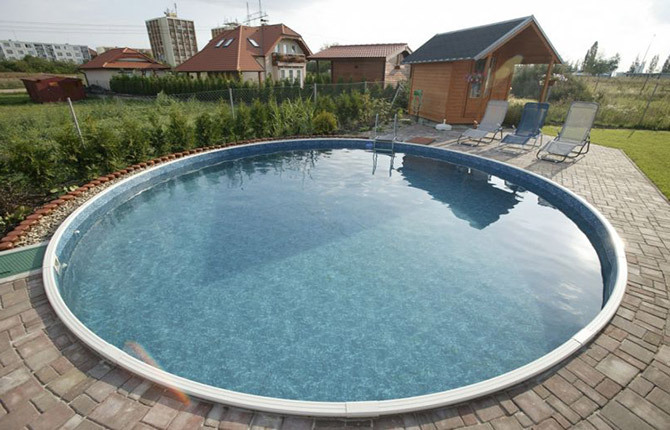
Indoor pool materials and tools
The roof frame must have high strength and rigidity. This is important, since the covered superstructure experiences a significant load in summer from gusts of wind, rain, and in winter from a half-meter snow cap.
Therefore, for the construction of an indoor pool, you can use a steel square pipe or an aluminum window profile. It is better not to consider any options for building a covered part from polypropylene water pipes. Construction will cost less than from a metal profile, but a lightweight roof will last several times less than a steel or aluminum one.
Steel square tube is available in all sizes and sections. For the manufacture of an indoor pool, a square of 30x30 mm and 40x40 mm is mainly used.
For large reservoirs, roofs are made of metal-plastic window profiles. Ready-made sections can be ordered from a company that produces windows and fittings for them.
The result is a dome or superstructure of an arched type, strong enough to withstand rain or strong gusts of wind.
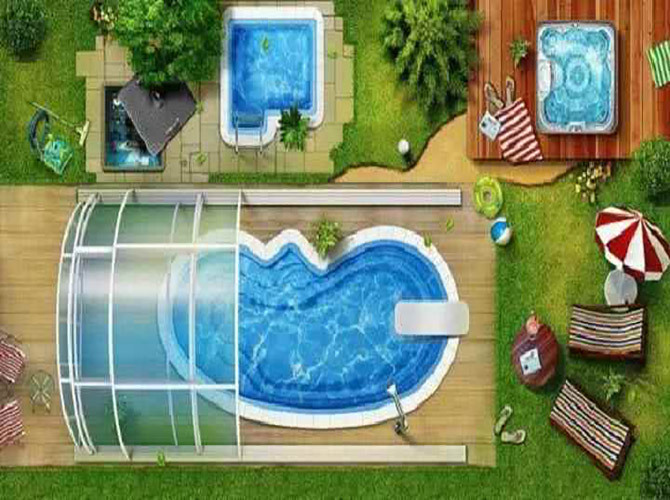
In addition to the pipe or finished sections, you will need:
- cellular two-chamber polycarbonate 8 mm thick with a set of gaskets, washers and self-tapping screws;
- sealant;
- orthophosphoric acid;
- polyester resin;
- gusset corners to reinforce welded joints.
Of the equipment for the construction of a covered superstructure, you will need a welding machine, a grinder, a jigsaw, a knife, a measuring tool, a screwdriver with a set of drills.
In addition, for the construction of the pool itself, a ready-made polypropylene bowl, concrete (up to 3 m3), red brick, boards, sand, crushed stone, polyethylene film, geotextiles, penoplex. Additionally, you will need to purchase a filter, a pump, plastic pipes for plumbing and drainage corrugations.
Interesting: Which pool is better, Bestway or Intex.
Types of pools
You can buy a bowl of a home pond ready-made or try to make it yourself. Frames (bowls) of small pools are cast from fiberglass or pressed from impact-resistant reinforced polypropylene. The dimensions of such a pool usually do not exceed 5x3m, but you can order a children's version - a small depth, but with a larger surface area.
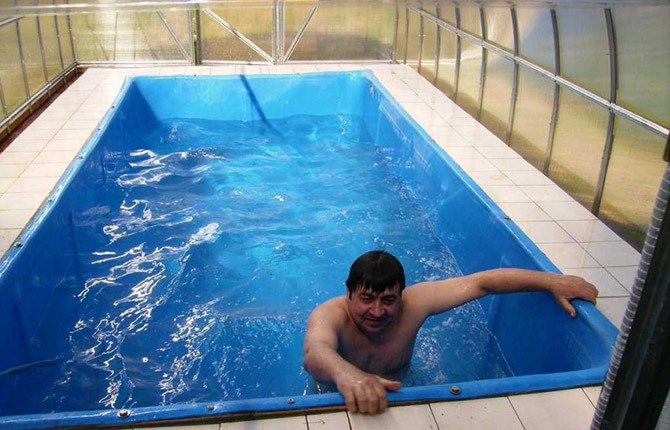
The second option - the bowl is laid out from a cinder block or cast from reinforced concrete. The cost of a do-it-yourself indoor pool bowl will cost more than a purchased polypropylene liner. Therefore, such a scheme with concreting is used mainly for indoor reservoirs of large size or non-standard shape.
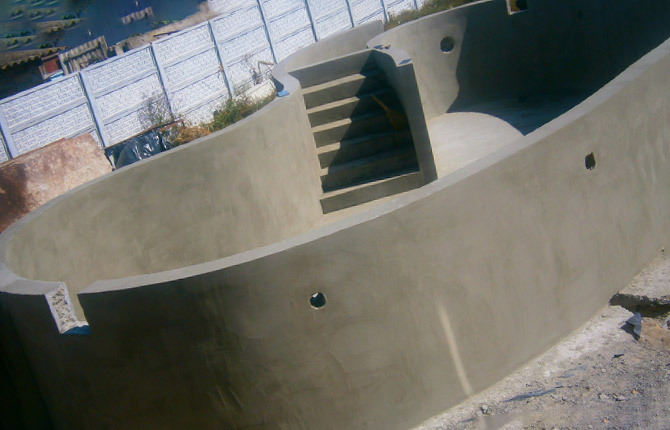
Healthy: How to make a pool from a Eurocube with your own hands.
Roof types and roof shapes
The installation scheme, material and shape of the roof are chosen depending on the chosen design of the indoor pool. If this is a simple arched canopy, then it is better to use cellular polycarbonate.
For flat roofs, solid polycarbonate is the ideal material for an indoor pool. It is recommended to install it on flat bases. The material is capricious - if the sheets are not properly fixed when assembling a covered superstructure, then the roof is often covered with a network of small cracks.
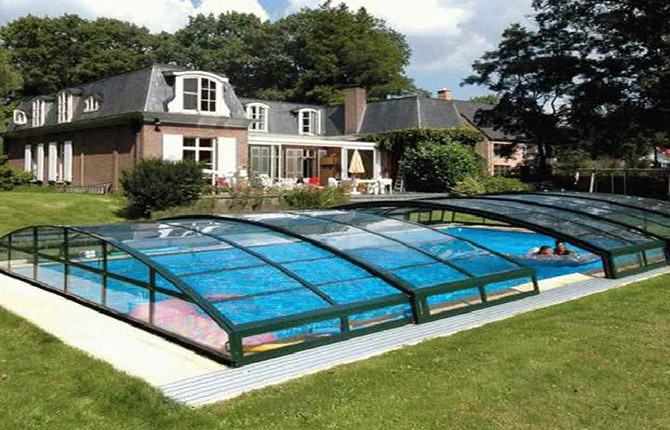
For small pools, a hinged roof structure is often used to free the pool for swimming, it is enough to open or move the wings to the side. The scheme is quite simple, but after the opening of the protective canopy overhead, there will be no more swimmers.

Another option for the covered part is a folding roof-canopy or shell. Unlike the previous one, the protection is not plowed open, but lifted and fixed on supports. Quite a good solution, since the interior space above the mirror is well ventilated, while there are protected areas where you can hide from the wind or solar ultraviolet.
For long ponds, a covered superstructure is often made in the form of a sectional pavilion.
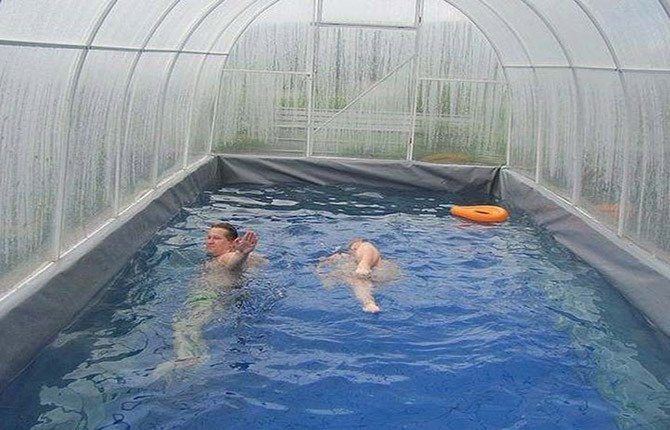
The roof is only a couple of meters high, but thanks to the ability to move the sections to the side, swimmers can swim both under the roof and under the covered superstructure.

There are also dome models of indoor pools, where the dome can be assembled into a package, opening part of the mirror for sunlight.

Many summer residents who own outdoor pools for a covered superstructure use ready-made greenhouses assembled from an aluminum pipe and polycarbonate or plastic film.
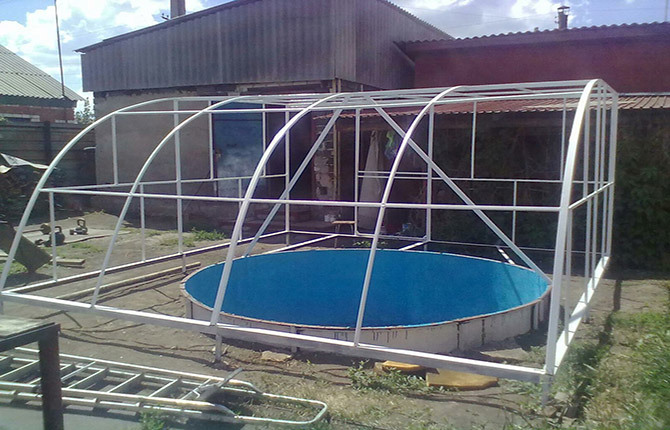
The dimensions of the greenhouse frame do not allow to completely close the stationary pool. Therefore, country roof-greenhouses are used as a covered superstructure mainly for soft frame reservoirs.
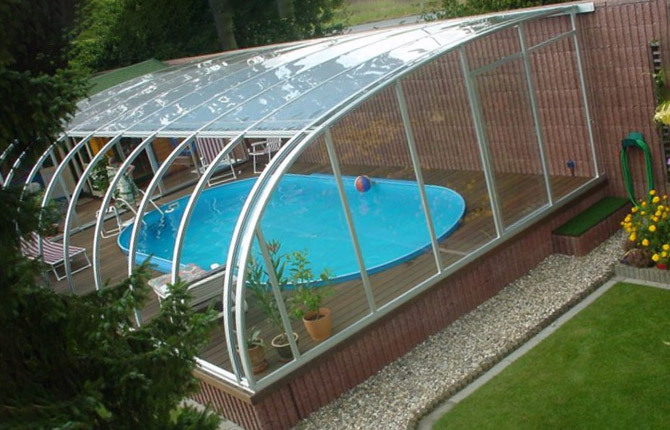
Step-by-step instructions for creating an indoor pool
First of all, you need to choose the right location for the indoor pool in the courtyard. It is necessary to hide the reservoir as much as possible, reduce wind loads on the covered part. In addition, you will need to plan and lay a hot water supply from the house, place a well with a pump and a filter.
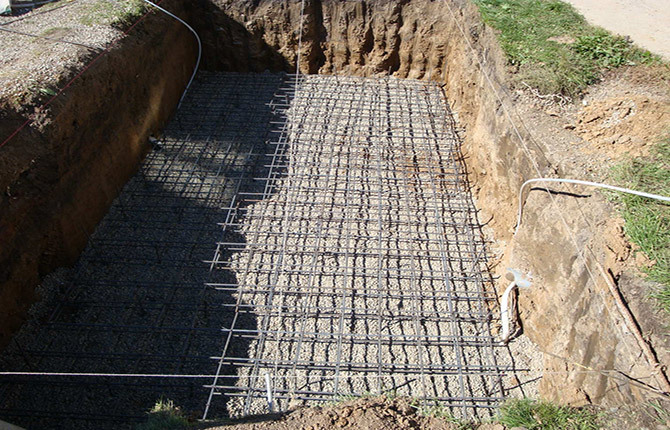
Foundation preparation
The pit is always made larger and deeper than the actual dimensions of the plastic bowl. Before installing the liner, you will need to make a base plate-foundation:
- The bottom of the pit is compacted with a manual or electric rammer.
- A layer of gravel up to 20 cm thick is laid.
- Geotextiles and a layer of sand up to 10 cm thick are laid on top.
Next, a thick polyethylene film and two layers of reinforcing mesh are laid. The reinforcement is poured with concrete. It turns out a plate with a thickness of about 15 cm. On top of the slab foundation, you need to lay a layer of foam, this is the insulation of the bottom of the pool.
Indoor pool bowl installation
To install a plastic liner in the pit, you will need a dozen workers or a truck crane with two additional assistants.
When installing, the bowl must be leveled and fixed with boards. There is a gap between the wall of the pit and the bowl. The soil walls are covered with polyethylene, after which the space is covered with foam glass granules and grated clay. Part of the soil around the plastic liner is cut with shovels to a depth of 50 cm.
The site is covered with gravel (10 cm) and sand (5 cm). That is, the upper edge of the liner will protrude above the level of the site. It will need to be overlaid with brickwork to the height of the side. Leave only an allowance for tiling.

Supports for covered superstructure
It is impossible to fasten the roof frame to the brickwork. Therefore, to install the covered part of the pool, you need to make a columnar foundation. A two-row scheme will be used with four pillars in each row. The supports for the frame of the covered part are made by pouring concrete into the formwork knocked down from the boards.
Between the extreme pillars you need to stretch the building cords. In order for the covered canopy to stand evenly, the surface of the supports after the concrete has hardened must be cut to the level (cord).
As soon as the concrete has set, holes must be drilled in the pillars and anchor studs or trimmings of reinforcement with a diameter of up to 20 mm should be laid. After the concrete has hardened, the studs (reinforcement) of the supports are tied around the perimeter with a square pipe 40x40 mm. They are attached to the embedded elements either by welding or by nuts.
After laying pipes and drains, building a well for a filter and a pump, the area around the pool is covered with gravel, then with sand for laying decorative tiles. During rain, water will drain through the covered canopy to the site, so before filling it is necessary to make waterproofing with a film and lay drainage pipes.
The gaps between the supports will need to be laid with brickwork half a brick thick. The wall will give the frame of the covered superstructure additional stability.
Useful: Pool waterproofing materials.
Making the frame of the covered part
The frame is best assembled from half-arcs bent on a pipe bending machine from a square profile with a section of 30x30 mm. If the height of the covered superstructure is more than 2.5 m and the width is more than 4 m, then a 40x40 mm square can be used.
The number of sections (semi-arcs) depends on the length of the covered superstructure. Optimally they are installed in increments of one meter. That is, to assemble a roof 6 m long, 10 arcs are required.
In addition, on the front side, a frame for the door frame will need to be welded. Two window frames are welded on the back side. The interior of the indoor pool should be regularly ventilated.
Assembling the frame of the covered part
The front and back parts of the frame are installed first. To prevent the parts from falling, they are fixed with temporary struts made of slabs and boards. Next, you need to lay and weld two ridge beams from a 30x50 mm pipe.
Before installation, each half-arc is adjusted in height by trimming the ends. The part is installed in the frame of the covered part and welded by welding.
After completion of the assembly, all welds are reinforced by welding gussets from sheet steel. Only after that it will be necessary to treat the metal with an etching solution (orthophosphoric acid), primed and coated with polyester resin.
Reading: How to make a wood burning stove for the pool with your own hands.
Laying cladding for an indoor pool
Since a square-section steel pipe was used for the frame, laying the cladding on the half-arcs will not be difficult. For glazing, it is best to use a two-chamber cellular polycarbonate 8 mm thick with protection against the accumulation of condensate.
The only problem is to cut the polycarbonate sheets correctly. The cut line must be sealed with adhesive tape, and for cutting, saws with a fine tooth are used for cutting metal.
Polycarbonate is laid on the covered part of the pool, always with a compensating gap between the edges, the ends are sealed with gaskets. Fastening is carried out using special self-tapping screws with a wide head and a compensating gasket. After laying the lining on the covered part of the reservoir, the joints are additionally treated with a sealant that is resistant to ultraviolet radiation.
To give the covered part a more elegant appearance, the joints are closed with decorative overlays.
Building an indoor pool with your own hands will require a lot of time and effort. On average, construction takes up to two weeks from the moment the foundation pit is laid. In terms of costs, an indoor reservoir made of a profiled pipe is half the price of a purchased roof. If you do not violate the technology, then the covered part will stand for at least 20 years.
Tell us about your experience building an indoor pool. What roof scheme is best suited for a home pond.


